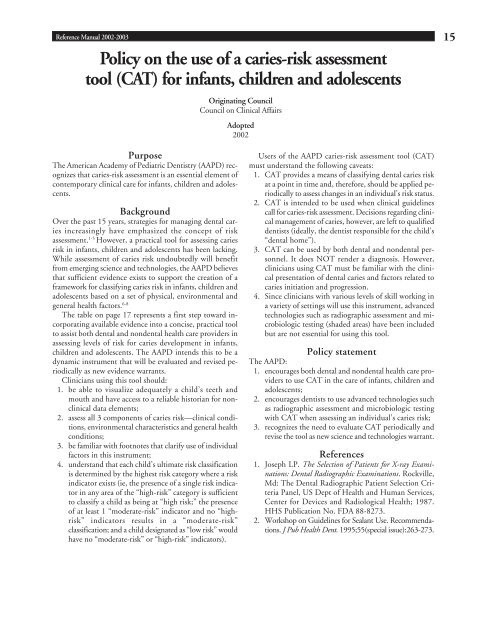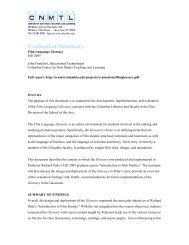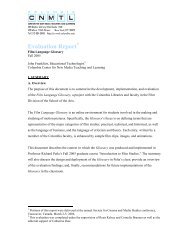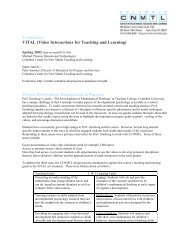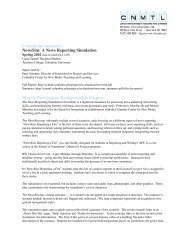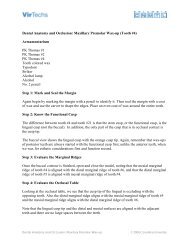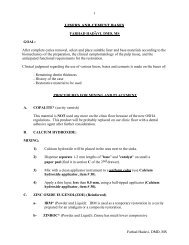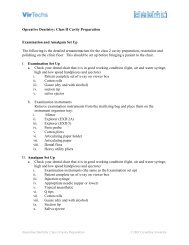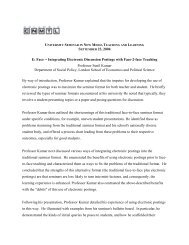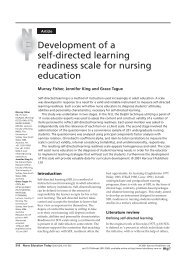Policy on the use of a caries-risk assessment tool (CAT) for infants ...
Policy on the use of a caries-risk assessment tool (CAT) for infants ...
Policy on the use of a caries-risk assessment tool (CAT) for infants ...
You also want an ePaper? Increase the reach of your titles
YUMPU automatically turns print PDFs into web optimized ePapers that Google loves.
Reference Manual 2002-2003<br />
<str<strong>on</strong>g>Policy</str<strong>on</strong>g> <strong>on</strong> <strong>the</strong> <strong>use</strong> <strong>of</strong> a <strong>caries</strong>-<strong>risk</strong> <strong>assessment</strong><br />
<strong>tool</strong> (<strong>CAT</strong>) <strong>for</strong> <strong>infants</strong>, children and adolescents<br />
Purpose<br />
The American Academy <strong>of</strong> Pediatric Dentistry (AAPD) recognizes<br />
that <strong>caries</strong>-<strong>risk</strong> <strong>assessment</strong> is an essential element <strong>of</strong><br />
c<strong>on</strong>temporary clinical care <strong>for</strong> <strong>infants</strong>, children and adolescents.<br />
Background<br />
Over <strong>the</strong> past 15 years, strategies <strong>for</strong> managing dental <strong>caries</strong><br />
increasingly have emphasized <strong>the</strong> c<strong>on</strong>cept <strong>of</strong> <strong>risk</strong><br />
<strong>assessment</strong>. 1-5 However, a practical <strong>tool</strong> <strong>for</strong> assessing <strong>caries</strong><br />
<strong>risk</strong> in <strong>infants</strong>, children and adolescents has been lacking.<br />
While <strong>assessment</strong> <strong>of</strong> <strong>caries</strong> <strong>risk</strong> undoubtedly will benefit<br />
from emerging science and technologies, <strong>the</strong> AAPD believes<br />
that sufficient evidence exists to support <strong>the</strong> creati<strong>on</strong> <strong>of</strong> a<br />
framework <strong>for</strong> classifying <strong>caries</strong> <strong>risk</strong> in <strong>infants</strong>, children and<br />
adolescents based <strong>on</strong> a set <strong>of</strong> physical, envir<strong>on</strong>mental and<br />
general health factors. 6-8<br />
The table <strong>on</strong> page 17 represents a first step toward incorporating<br />
available evidence into a c<strong>on</strong>cise, practical <strong>tool</strong><br />
to assist both dental and n<strong>on</strong>dental health care providers in<br />
assessing levels <strong>of</strong> <strong>risk</strong> <strong>for</strong> <strong>caries</strong> development in <strong>infants</strong>,<br />
children and adolescents. The AAPD intends this to be a<br />
dynamic instrument that will be evaluated and revised periodically<br />
as new evidence warrants.<br />
Clinicians using this <strong>tool</strong> should:<br />
1. be able to visualize adequately a child’s teeth and<br />
mouth and have access to a reliable historian <strong>for</strong> n<strong>on</strong>clinical<br />
data elements;<br />
2. assess all 3 comp<strong>on</strong>ents <strong>of</strong> <strong>caries</strong> <strong>risk</strong>—clinical c<strong>on</strong>diti<strong>on</strong>s,<br />
envir<strong>on</strong>mental characteristics and general health<br />
c<strong>on</strong>diti<strong>on</strong>s;<br />
3. be familiar with footnotes that clarify <strong>use</strong> <strong>of</strong> individual<br />
factors in this instrument;<br />
4. understand that each child’s ultimate <strong>risk</strong> classificati<strong>on</strong><br />
is determined by <strong>the</strong> highest <strong>risk</strong> category where a <strong>risk</strong><br />
indicator exists (ie, <strong>the</strong> presence <strong>of</strong> a single <strong>risk</strong> indicator<br />
in any area <strong>of</strong> <strong>the</strong> “high-<strong>risk</strong>” category is sufficient<br />
to classify a child as being at “high <strong>risk</strong>;” <strong>the</strong> presence<br />
<strong>of</strong> at least 1 “moderate-<strong>risk</strong>” indicator and no “high<strong>risk</strong>”<br />
indicators results in a “moderate-<strong>risk</strong>”<br />
classificati<strong>on</strong>; and a child designated as “low <strong>risk</strong>” would<br />
have no “moderate-<strong>risk</strong>” or “high-<strong>risk</strong>” indicators).<br />
Originating Council<br />
Council <strong>on</strong> Clinical Affairs<br />
Adopted<br />
2002<br />
Users <strong>of</strong> <strong>the</strong> AAPD <strong>caries</strong>-<strong>risk</strong> <strong>assessment</strong> <strong>tool</strong> (<strong>CAT</strong>)<br />
must understand <strong>the</strong> following caveats:<br />
1. <strong>CAT</strong> provides a means <strong>of</strong> classifying dental <strong>caries</strong> <strong>risk</strong><br />
at a point in time and, <strong>the</strong>re<strong>for</strong>e, should be applied periodically<br />
to assess changes in an individual’s <strong>risk</strong> status.<br />
2. <strong>CAT</strong> is intended to be <strong>use</strong>d when clinical guidelines<br />
call <strong>for</strong> <strong>caries</strong>-<strong>risk</strong> <strong>assessment</strong>. Decisi<strong>on</strong>s regarding clinical<br />
management <strong>of</strong> <strong>caries</strong>, however, are left to qualified<br />
dentists (ideally, <strong>the</strong> dentist resp<strong>on</strong>sible <strong>for</strong> <strong>the</strong> child’s<br />
“dental home”).<br />
3. <strong>CAT</strong> can be <strong>use</strong>d by both dental and n<strong>on</strong>dental pers<strong>on</strong>nel.<br />
It does NOT render a diagnosis. However,<br />
clinicians using <strong>CAT</strong> must be familiar with <strong>the</strong> clinical<br />
presentati<strong>on</strong> <strong>of</strong> dental <strong>caries</strong> and factors related to<br />
<strong>caries</strong> initiati<strong>on</strong> and progressi<strong>on</strong>.<br />
4. Since clinicians with various levels <strong>of</strong> skill working in<br />
a variety <strong>of</strong> settings will <strong>use</strong> this instrument, advanced<br />
technologies such as radiographic <strong>assessment</strong> and microbiologic<br />
testing (shaded areas) have been included<br />
but are not essential <strong>for</strong> using this <strong>tool</strong>.<br />
<str<strong>on</strong>g>Policy</str<strong>on</strong>g> statement<br />
The AAPD:<br />
1. encourages both dental and n<strong>on</strong>dental health care providers<br />
to <strong>use</strong> <strong>CAT</strong> in <strong>the</strong> care <strong>of</strong> <strong>infants</strong>, children and<br />
adolescents;<br />
2. encourages dentists to <strong>use</strong> advanced technologies such<br />
as radiographic <strong>assessment</strong> and microbiologic testing<br />
with <strong>CAT</strong> when assessing an individual’s <strong>caries</strong> <strong>risk</strong>;<br />
3. recognizes <strong>the</strong> need to evaluate <strong>CAT</strong> periodically and<br />
revise <strong>the</strong> <strong>tool</strong> as new science and technologies warrant.<br />
References<br />
1. Joseph LP. The Selecti<strong>on</strong> <strong>of</strong> Patients <strong>for</strong> X-ray Examinati<strong>on</strong>s:<br />
Dental Radiographic Examinati<strong>on</strong>s. Rockville,<br />
Md: The Dental Radiographic Patient Selecti<strong>on</strong> Criteria<br />
Panel, US Dept <strong>of</strong> Health and Human Services,<br />
Center <strong>for</strong> Devices and Radiological Health; 1987.<br />
HHS Publicati<strong>on</strong> No. FDA 88-8273.<br />
2. Workshop <strong>on</strong> Guidelines <strong>for</strong> Sealant Use. Recommendati<strong>on</strong>s.<br />
J Pub Health Dent. 1995;55(special issue):263-273.<br />
15
16<br />
3. Casamassimo P. Bright Futures in Practice: Oral Health.<br />
Arlingt<strong>on</strong>, Va: Nati<strong>on</strong>al Center <strong>for</strong> Educati<strong>on</strong> in Maternal<br />
and Child Health; 1996.<br />
4. Centers <strong>for</strong> Disease C<strong>on</strong>trol and Preventi<strong>on</strong>. Recommendati<strong>on</strong>s<br />
<strong>for</strong> using fluoride to prevent and c<strong>on</strong>trol<br />
dental <strong>caries</strong> in <strong>the</strong> United States. MMWR. August 17,<br />
2001;50 (RR14): 1-42.<br />
5. American Academy <strong>of</strong> Pediatric Dentistry. Guideline<br />
<strong>on</strong> periodicity <strong>of</strong> examinati<strong>on</strong>, preventive dental services,<br />
anticipatory guidance and oral treatment <strong>for</strong><br />
children. Pediatr Dent. 2002;24(7):51-52.<br />
6. US Dept <strong>of</strong> Health and Human Services. Oral Health<br />
in America: A Report <strong>of</strong> <strong>the</strong> Surge<strong>on</strong> General. Rockville,<br />
Md: US Dept <strong>of</strong> Health and Human Services, Nati<strong>on</strong>al<br />
American Academy <strong>of</strong> Pediatric Dentistry<br />
Institute <strong>of</strong> Dental and Crani<strong>of</strong>acial Research, Nati<strong>on</strong>al<br />
Institutes <strong>of</strong> Health; 2000.<br />
7. Vargas C, Crall J, Schneider D. Sociodemographic distributi<strong>on</strong><br />
<strong>of</strong> pediatric dental <strong>caries</strong>: NHANES III,<br />
1988-1994. JADA. 1998;129:1229-1238.<br />
8. Ekstrand KR, Bruun G, Bruun M. Plaque and gingival<br />
status as indicators <strong>for</strong> <strong>caries</strong> progressi<strong>on</strong> <strong>on</strong><br />
approximal surfaces. Caries Res. 1998;32:41-45.<br />
9. Newacheck PW, Marchi K, McManus MA, Fox HB.<br />
New estimates <strong>of</strong> children with special health care<br />
needs and implicati<strong>on</strong>s <strong>for</strong> <strong>the</strong> state children’s health<br />
insurance program. Maternal and Child Health <str<strong>on</strong>g>Policy</str<strong>on</strong>g><br />
Research Center Fact Sheet; March 1998.
Reference Manual 2002-2003<br />
AAPD Caries-<strong>risk</strong> Assessment Tool (<strong>CAT</strong>)<br />
Caries-<strong>risk</strong> indicators<br />
Clinical c<strong>on</strong>diti<strong>on</strong>s<br />
Low <strong>risk</strong> Moderate <strong>risk</strong> High <strong>risk</strong><br />
• No carious teeth in • Carious teeth in <strong>the</strong> • Carious teeth in <strong>the</strong><br />
past 24 m<strong>on</strong>ths past 24 m<strong>on</strong>ths past 12 m<strong>on</strong>ths<br />
• No enamel demineralizati<strong>on</strong> • 1 area <strong>of</strong> enamel demineralizati<strong>on</strong> • More than 1 area <strong>of</strong> enamel<br />
(enamel <strong>caries</strong> “white-spot lesi<strong>on</strong>s”) (enamel <strong>caries</strong> “white-spot lesi<strong>on</strong>s”) demineralizati<strong>on</strong> (enamel<br />
<strong>caries</strong> “white-spot<br />
lesi<strong>on</strong>s”)<br />
• No visible plaque; no gingivitis<br />
Envir<strong>on</strong>mental characteristics<br />
• Gingivitis* • Visible plaque <strong>on</strong> anterior<br />
(fr<strong>on</strong>t) teeth<br />
• Radiographic enamel <strong>caries</strong><br />
• High titers <strong>of</strong> mutans streptococci<br />
• Wearing dental or orthod<strong>on</strong>tic<br />
appliances†<br />
• Enamel hypoplasia‡<br />
• Optimal systemic and • Suboptimal systemic fluoride exposure • Suboptimal topical<br />
topical fluoride exposure§ with optimal topical exposure§ fluoride exposure§<br />
• C<strong>on</strong>sumpti<strong>on</strong> <strong>of</strong> simple sugars • Occasi<strong>on</strong>al (ie, 1-2) between-meal • Frequent (ie, 3 or more)<br />
or foods str<strong>on</strong>gly associated exposures to simple sugars or between-meal exposures<br />
with <strong>caries</strong> initiati<strong>on</strong>|| foods str<strong>on</strong>gly associated with <strong>caries</strong> to simple sugars or foods<br />
primarily at mealtimes str<strong>on</strong>gly associated with <strong>caries</strong><br />
• High caregiver • Midlevel caregiver • Low-level caregiver<br />
socioec<strong>on</strong>omic status socioec<strong>on</strong>omic status socioec<strong>on</strong>omic status<br />
(ie, eligible <strong>for</strong> school<br />
lunch program or SCHIP)<br />
(ie, eligible <strong>for</strong> Medicaid)<br />
• Regular <strong>use</strong> <strong>of</strong> dental care<br />
in an established dental home<br />
General health c<strong>on</strong>diti<strong>on</strong>s<br />
• Irregular <strong>use</strong> <strong>of</strong> dental services • No usual source <strong>of</strong> dental care<br />
• Active <strong>caries</strong> present in <strong>the</strong> mo<strong>the</strong>r<br />
• Children with special health<br />
care needs#<br />
• C<strong>on</strong>diti<strong>on</strong>s impairing saliva<br />
compositi<strong>on</strong>/flow**<br />
*Although microbial organisms resp<strong>on</strong>sible <strong>for</strong> gingivitis may be different than those primarily implicated in dental <strong>caries</strong>, <strong>the</strong> presence <strong>of</strong> gingivitis<br />
is an indicator <strong>of</strong> poor or infrequent oral hygiene practices and has been associated with <strong>caries</strong> progressi<strong>on</strong><br />
†Orthod<strong>on</strong>tic appliances include both fixed and removable appliances, space maintainers and o<strong>the</strong>r devices that remain in <strong>the</strong> mouth c<strong>on</strong>tinuously<br />
or <strong>for</strong> prol<strong>on</strong>ged time intervals and which may trap food and plaque, prevent oral hygiene, compromise access <strong>of</strong> tooth surfaces to fluoride or<br />
o<strong>the</strong>rwise create an envir<strong>on</strong>ment supporting dental <strong>caries</strong> initiati<strong>on</strong><br />
‡Tooth anatomy and hypoplastic defects such as poorly <strong>for</strong>med enamel, developmental pits and deep pits may predispose a child to develop dental<br />
<strong>caries</strong><br />
§Optimal systemic and topical fluoride exposure is based <strong>on</strong> <strong>the</strong> American Dental Associati<strong>on</strong>/American Academy <strong>of</strong> Pediatrics guidelines <strong>for</strong><br />
exposure from fluoride drinking water and/or supplementati<strong>on</strong> 4 and <strong>use</strong> <strong>of</strong> a fluoride dentifrice<br />
||Examples <strong>of</strong> sources <strong>of</strong> simple sugars include carb<strong>on</strong>ated beverages, cookies, cake, candy, cereal, potato chips, french fries, corn chips, pretzels,<br />
breads, juices and fruits. Clinicians using <strong>caries</strong>-<strong>risk</strong> <strong>assessment</strong> should investigate individual exposures to sugars known to be involved in <strong>caries</strong><br />
initiati<strong>on</strong>.<br />
Nati<strong>on</strong>al surveys have dem<strong>on</strong>strated that children in low-income and moderate-income ho<strong>use</strong>holds are more likely to have dental <strong>caries</strong> and more<br />
decayed or filled primary teeth than children from more affluent ho<strong>use</strong>holds. Also, within income levels, minority children are more likely to have<br />
<strong>caries</strong>. Thus, sociodemographic status should be viewed as an initial indicator <strong>of</strong> <strong>risk</strong> that may be <strong>of</strong>fset by <strong>the</strong> absence <strong>of</strong> o<strong>the</strong>r <strong>risk</strong> indicators.<br />
#Children with special health care needs are those who have or are at increased <strong>risk</strong> <strong>for</strong> a chr<strong>on</strong>ic physical, developmental, behavioral or emoti<strong>on</strong>al<br />
c<strong>on</strong>diti<strong>on</strong> and who also require health and related services <strong>of</strong> a type or amount bey<strong>on</strong>d that required by children generally 9<br />
**Alterati<strong>on</strong> in salivary flow can be <strong>the</strong> result <strong>of</strong> c<strong>on</strong>genital or acquired c<strong>on</strong>diti<strong>on</strong>s, surgery, radiati<strong>on</strong>, medicati<strong>on</strong> or age-related changes in salivary<br />
functi<strong>on</strong>. Any c<strong>on</strong>diti<strong>on</strong>, treatment or process known or reported to alter saliva flow should be c<strong>on</strong>sidered an indicati<strong>on</strong> <strong>of</strong> <strong>risk</strong> unless proven<br />
o<strong>the</strong>rwise.<br />
17


